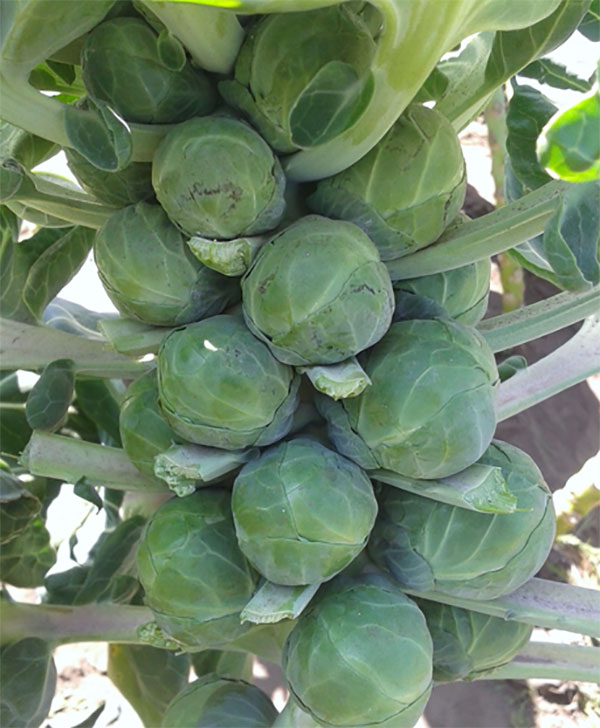Taking an environmentally sensitive approach to pest management
Brussels Sprouts Prolong Fall Harvest
Published: October 8, 2018
Brussels sprouts are part of the Gemmifera Group of Brassica oleracea (cabbage). This somewhat obscure garden vegetable is grown for its edible buds (sprouts) that are produced in its leaf axils. Unlike cabbage, however, Brussels sprouts can stand considerable freezing weather and, therefore, can be harvested late into the fall or early winter. The cool sunny days and crisp nights of fall result in Brussels sprouts of excellent quality from the standpoint of firmness and mild flavor.

Considered to be one of the newer members of the cabbage family, Brussels sprouts is thought to have first appeared in northern Europe during the fifth century. One of the first reliable references describing the plant is dated 1587. Later, it became popular in the cooler parts of Europe including the area now occupied by Belgium, which accounts for its common name. The latter often is misrepresented as Brussel sprouts or Brussels sprout. The correct version of its name is Brussels sprouts, which is both singular and plural.
As a rule, Brussels sprouts require a long growing period to develop edible sprouts. Because of this, hot weather often arrives too soon in Missouri to allow for successful production from an early spring planting. Sprouts that develop in hot weather tend to be loose and "fluffy", and have an undesirable flavor. Even though hybrids have been developed with shorter maturities, this garden vegetable still is marginal as a spring crop in our climate.
In contrast, plants set into the garden in June will develop their sprouts in fall, when there normally is a much longer period of cool weather ideal for growth. Even a Brussels sprouts planting that did not have time to produce a good early summer crop can be kept growing and should produce a late fall crop that can be harvested through November.
If Brussels sprouts are not a part of your fall harvest this year, but you are considering adding them to your garden next season, remember they have approximately the same needs as cabbage, broccoli and cauliflower. They are heavy feeders and thrive in a rich, well-drained soil high in organic matter. Side dressing with a fertilizer high in nitrogen several times during the summer is beneficial to keep plants growing vigorously until cool weather arrives.
Numerous varieties of Brussels sprouts are available. When selecting one for this area, pay close attention to the time needed for sprout development after planting. The latter may range from 80 to as many as 120 days, depending upon variety. The best chance for success in Missouri includes planting early-maturing varieties. Good choices include Jade Cross Hybrid (80 days), Royal Marvel (85 days) and Prince Marvel (90 days).
When planning the garden, remember that Brussels sprouts will occupy space for the entire summer and late into fall. Since their leaves are relatively large, plants should be spaced 18 to 24 inches apart. They also tend to grow tall. Therefore, staking or some other form of support will prevent summer storms from toppling them over.
Because Brussels sprouts can tolerate temperatures as low as 0 degrees F, harvest is possible until late November, or beyond. In fact, in milder climates, this crop may be harvested throughout the winter. Generally, when day temperatures no longer rise above 52 degrees F, plant growth ceases but the sprouts continue to survive. Flavor normally improves after frost in the fall.
To harvest Brussels sprouts, pick them from the bottom of the stem upward, as they develop in the leaf axils. When sprouts are harvested, the leaf at that point on the stem may be removed and discarded. If the outer leaves of the harvested sprouts are loose, they should be removed so that only the firm center of the spout remains for consumption. Flavor is best when Brussels sprouts are consumed as soon after harvest as possible. Excess sprouts may be placed in a plastic bag and refrigerated. Brussels sprouts also freeze well, if blanched before placing them in a freezer.
Brussels sprouts are "nutritional powerhouses". High in dietary fiber, they are especially rich in vitamins C and K. Additionally, they are a good source of essential minerals and a rich source of antioxidants such as kaempferol. Recent research indicates consuming the latter may reduce the risk of various cancers and also provide other health benefits. In short, including Brussels sprouts in a well-balanced diet is a sound way to promote one's physical well-being.
Although most gardeners do not devote a large amount of space to this crop, Brussels sprouts is worth adding to the garden to extend harvest well beyond the end of the growing season. Now is a good time to make plans for next year's crop.
Subscribe to receive similar articles sent directly to your inbox!
- Brussels Sprouts Prolong Fall Harvest (10/08/18)
REVISED: February 21, 2017